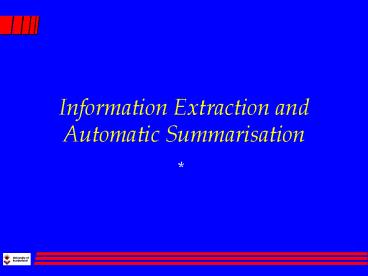Information Extraction and Automatic Summarisation PowerPoint PPT Presentation
1 / 12
Title: Information Extraction and Automatic Summarisation
1
Information Extraction and Automatic Summarisation
2
How IE fits in with IR
- IR selects a few relevant documents from many
- IE starts with one or a few relevant documents
- IE pulls out the words and phrases most central
to the meaning of that/those documents to produce
an extract.
3
Two process associated with information extraction
- determination of facts to go into structured
fields in a database. - extraction of text that can be used to summarise
an item. - In the first case only a subset of the important
facts in an item may be identified and extracted.
The term slot is used to define a particular
category of information to be extracted. Slots
are organised into semantic frames.
4
What do we most want to know from a journal
article about agriculture?
- AGENT chemical agent applied
- CV cultivar (e.g. King Edward)
- HLP high level property (e.g. yield)
- INF influence (e.g. drought)
- LAB site of test (e.g. laboratory)
- LLP low level property (e.g. root mass)
- LOC location
- PEST pest or disease
- SOIL soil
- SPEC crop species (e.g. potato)
5
Automatic Abstracting
- In the second case, rather than trying to
determine specific facts, the goal of document
summarisation is to extract a summary of an item
maintaining the most important ideas while
significantly reducing its size. For journal
articles, this is called automatic abstracting.
The abstract is a way for the user to determine
the utility of an article without having to read
the whole item.
6
Kupieks heuristics
- Sentence length feature that requires the
sentence to be over five words in length. - Fixed phrase feature that looks for the existence
of phrase cues, e.g. in conclusion. - Paragraph feature that places emphasis on the
first ten and the last five paragraphs in an item
and also the location of the sentences within the
paragraph. - Thematic word feature that uses word frequency.
- Uppercase word feature that places emphasis on
proper names and acronyms. - discovered that location based heuristics give
better results than the frequency based features.
7
Paices rules
- Frequency Keyword Approach First find a set of
index terms for the document (manually,
mid-frequency, tf idf, words occurring in the
title, etc.). Then choose the sentences which
contain most keywords. - Location The first sentence in a paragraph is
most central to the theme of a text. The last
sentence is the next most central. - Cue method Not actually keywords, but their
presence in a document show that the sentence is
(or is not) important. These may be bonus words,
e.g. greatest, significant, or stigma words, e.g.
hardly, impossible. - Indicator phrases, e.g. The main aim of our
paper is to describe , Our investigation has
shown that .
8
Hoey method cohesion in text.
- The most important sentences in a document are
those which are related to the largest number of
other sentences. Find how many concepts in each
sentence are related to concepts in other
sentences. Concepts may be related by - Exact match, e.g. computer and computer
- Grammatical variants e.g. computer, computing
- Synonyms e.g. sedate, tranquilise, drug
- Antonymy e.g. cold, hot
- General-specific e.g. scientists, biologists
9
Hoey (2)
- Form a repetition net, with entries in the form s
( a , b) such as 26 ( 6, 4) meaning sentence no.
26 is bonded to 6 earlier sentences and 4 later
sentences. - If a b is high, the sentence is central to the
topic - If only b is high, the sentence is a topic
opener - If only a is high, the sentence is topic closing.
10
Hoey (3)
- Cohesion in text is concerned with explicit
references within a sentence which can only be
understood by reference to material elsewhere in
the text. - Anaphora come after their explicit mention in the
text, e.g. Marie Curie was born in Warsaw. She
devoted her life to the study of radioactivity. - Cataphora come before their explicit mention in
the text, e.g. He was to become the best known
physicist of his generation. His name was Albert
Einstein.
11
Generating Canned Text
- This paper studies the effect of AGENT on the HLP
of SPEC - OR
- This paper studies the effect of INF on the HLP
of SPEC - when it is infested by PEST.
- An experiment was undertaken
- using cultivars CV
- in, at LOC
- where the soil was SOIL.
- The HLP is, are measured by analysing the LLP.
12
Extracts vs. Abstracts (Mani, p6)
- An extract is a summary consisting entirely of
material copied from the input - An abstract is a summary at least some of whose
material is not present in the input.

